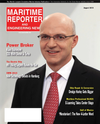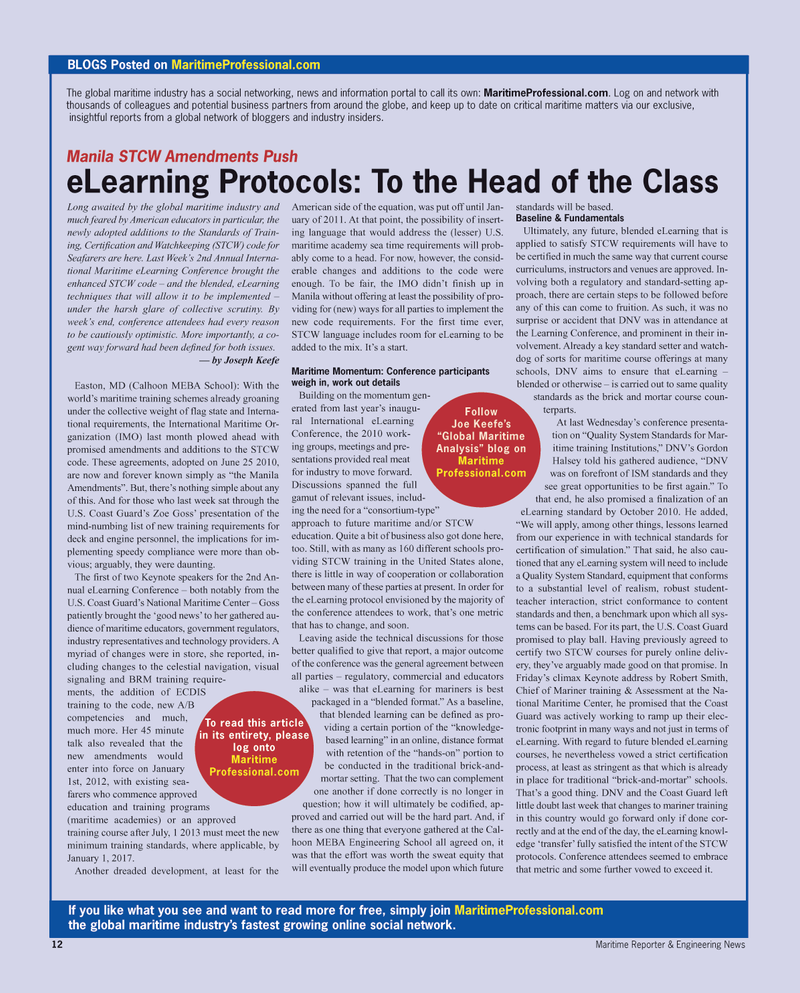
Page 12: of Maritime Reporter Magazine (August 2010)
The Electric Ship
Read this page in Pdf, Flash or Html5 edition of August 2010 Maritime Reporter Magazine
12 Maritime Reporter & Engineering News
The global maritime industry has a social networking, news and information portal to call its own: MaritimeProfessional.com. Log on and network with thousands of colleagues and potential business partners from around the globe, and keep up to date on critical maritime matters via our exclusive, insightful reports from a global network of bloggers and industry insiders.
Long awaited by the global maritime industry and much feared by American educators in particular, the newly adopted additions to the Standards of Train- ing, Certification and Watchkeeping (STCW) code for
Seafarers are here. Last Week’s 2nd Annual Interna- tional Maritime eLearning Conference brought the enhanced STCW code – and the blended, eLearning techniques that will allow it to be implemented – under the harsh glare of collective scrutiny. By week’s end, conference attendees had every reason to be cautiously optimistic. More importantly, a co- gent way forward had been defined for both issues. — by Joseph Keefe
Easton, MD (Calhoon MEBA School): With the world’s maritime training schemes already groaning under the collective weight of flag state and Interna- tional requirements, the International Maritime Or- ganization (IMO) last month plowed ahead with promised amendments and additions to the STCW code. These agreements, adopted on June 25 2010, are now and forever known simply as “the Manila
Amendments”. But, there’s nothing simple about any of this. And for those who last week sat through the
U.S. Coast Guard’s Zoe Goss’ presentation of the mind-numbing list of new training requirements for deck and engine personnel, the implications for im- plementing speedy compliance were more than ob- vious; arguably, they were daunting.
The first of two Keynote speakers for the 2nd An- nual eLearning Conference – both notably from the
U.S. Coast Guard’s National Maritime Center – Goss patiently brought the ‘good news’ to her gathered au- dience of maritime educators, government regulators, industry representatives and technology providers. A myriad of changes were in store, she reported, in- cluding changes to the celestial navigation, visual signaling and BRM training require- ments, the addition of ECDIS training to the code, new A/B competencies and much, much more. Her 45 minute talk also revealed that the new amendments would enter into force on January 1st, 2012, with existing sea- farers who commence approved education and training programs (maritime academies) or an approved training course after July, 1 2013 must meet the new minimum training standards, where applicable, by
January 1, 2017.
Another dreaded development, at least for the
American side of the equation, was put off until Jan- uary of 2011. At that point, the possibility of insert- ing language that would address the (lesser) U.S. maritime academy sea time requirements will prob- ably come to a head. For now, however, the consid- erable changes and additions to the code were enough. To be fair, the IMO didn’t finish up in
Manila without offering at least the possibility of pro- viding for (new) ways for all parties to implement the new code requirements. For the first time ever,
STCW language includes room for eLearning to be added to the mix. It’s a start.
Maritime Momentum: Conference participants weigh in, work out details
Building on the momentum gen- erated from last year’s inaugu- ral International eLearning
Conference, the 2010 work- ing groups, meetings and pre- sentations provided real meat for industry to move forward.
Discussions spanned the full gamut of relevant issues, includ- ing the need for a “consortium-type” approach to future maritime and/or STCW education. Quite a bit of business also got done here, too. Still, with as many as 160 different schools pro- viding STCW training in the United States alone, there is little in way of cooperation or collaboration between many of these parties at present. In order for the eLearning protocol envisioned by the majority of the conference attendees to work, that’s one metric that has to change, and soon.
Leaving aside the technical discussions for those better qualified to give that report, a major outcome of the conference was the general agreement between all parties – regulatory, commercial and educators alike – was that eLearning for mariners is best packaged in a “blended format.” As a baseline, that blended learning can be defined as pro- viding a certain portion of the “knowledge- based learning” in an online, distance format with retention of the “hands-on” portion to be conducted in the traditional brick-and- mortar setting. That the two can complement one another if done correctly is no longer in question; how it will ultimately be codified, ap- proved and carried out will be the hard part. And, if there as one thing that everyone gathered at the Cal- hoon MEBA Engineering School all agreed on, it was that the effort was worth the sweat equity that will eventually produce the model upon which future standards will be based.
Baseline & Fundamentals
Ultimately, any future, blended eLearning that is applied to satisfy STCW requirements will have to be certified in much the same way that current course curriculums, instructors and venues are approved. In- volving both a regulatory and standard-setting ap- proach, there are certain steps to be followed before any of this can come to fruition. As such, it was no surprise or accident that DNV was in attendance at the Learning Conference, and prominent in their in- volvement. Already a key standard setter and watch- dog of sorts for maritime course offerings at many schools, DNV aims to ensure that eLearning – blended or otherwise – is carried out to same quality standards as the brick and mortar course coun- terparts.
At last Wednesday’s conference presenta- tion on “Quality System Standards for Mar- itime training Institutions,” DNV’s Gordon
Halsey told his gathered audience, “DNV was on forefront of ISM standards and they see great opportunities to be first again.” To that end, he also promised a finalization of an eLearning standard by October 2010. He added, “We will apply, among other things, lessons learned from our experience in with technical standards for certification of simulation.” That said, he also cau- tioned that any eLearning system will need to include a Quality System Standard, equipment that conforms to a substantial level of realism, robust student- teacher interaction, strict conformance to content standards and then, a benchmark upon which all sys- tems can be based. For its part, the U.S. Coast Guard promised to play ball. Having previously agreed to certify two STCW courses for purely online deliv- ery, they’ve arguably made good on that promise. In
Friday’s climax Keynote address by Robert Smith,
Chief of Mariner training & Assessment at the Na- tional Maritime Center, he promised that the Coast
Guard was actively working to ramp up their elec- tronic footprint in many ways and not just in terms of eLearning. With regard to future blended eLearning courses, he nevertheless vowed a strict certification process, at least as stringent as that which is already in place for traditional “brick-and-mortar” schools.
That’s a good thing. DNV and the Coast Guard left little doubt last week that changes to mariner training in this country would go forward only if done cor- rectly and at the end of the day, the eLearning knowl- edge ‘transfer’ fully satisfied the intent of the STCW protocols. Conference attendees seemed to embrace that metric and some further vowed to exceed it.
If you like what you see and want to read more for free, simply join MaritimeProfessional.com the global maritime industry’s fastest growing online social network.
BLOGS Posted on MaritimeProfessional.com
Manila STCW Amendments Push eLearning Protocols: To the Head of the Class
Follow
Joe Keefe’s “Global Maritime
Analysis” blog on
Maritime
Professional.com
To read this article in its entirety, please log onto
Maritime
Professional.com

 11
11

 13
13
